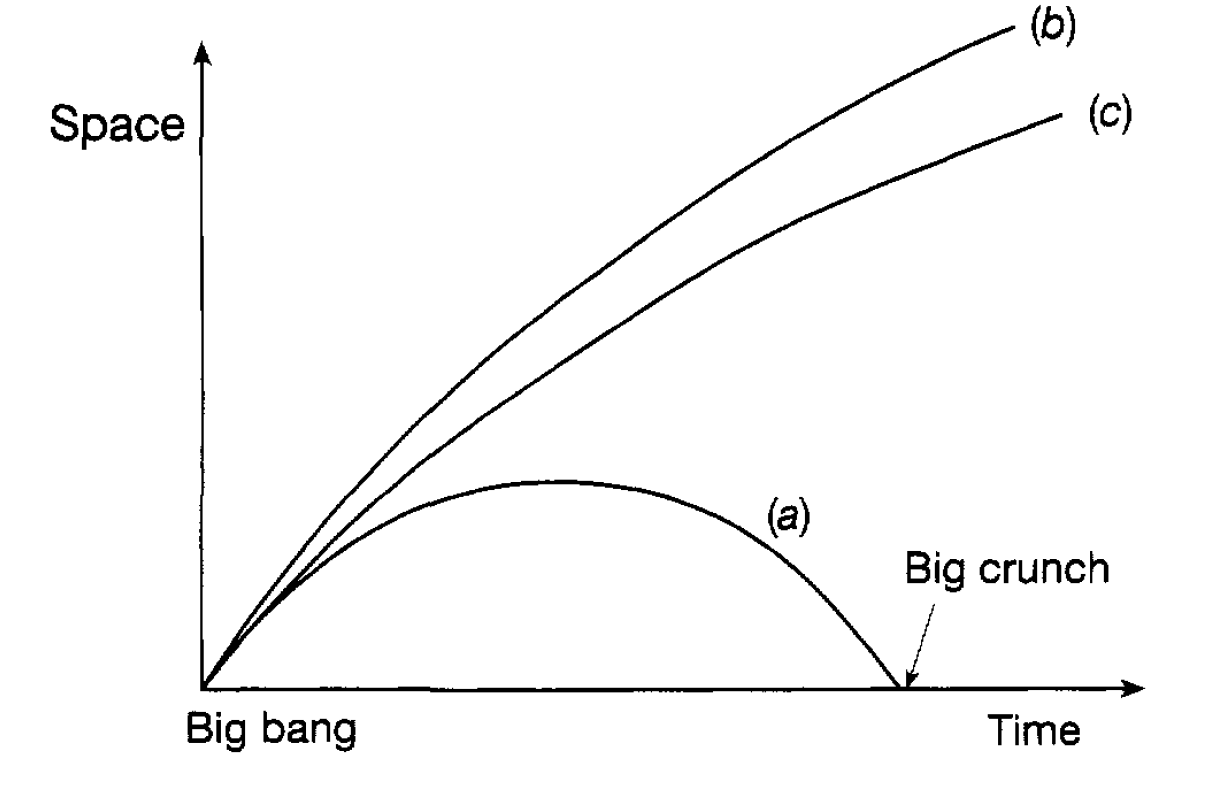The Expanding Universe and the Big Bang
Looking out into the universe with an optical telescope and studying in detail the spectrum of light emitted by stars in other galaxies than our own a most remarkable situation emerges. First of all the broad spectrum of light emitted by any star has a number of dark lines in it, implying that light of the corresponding frequency is being absorbed. Such absorption is readily understandable as being due to atoms in the stellar atmosphere and, the absorption spectrum should be characteristic of these atoms. Very recognizable patterns were indeed observed in the light from stars in our own galaxy. However, it was found that for distant stars the patterns of lines were not those of any known atoms. This mystery was solved when it was realized that the patterns were indeed identical with those of known atoms but with the frequencies all proportionally decreased by exactly the same amount. Since the shift to lower frequencies (and, therefore, longer wavelengths) is towards the red end of the spectrum it is universally known as the red shift. Such a shift is readily understandable if the corresponding stars are moving away from us at a very high speed and is caused by the Doppler effect. An intensive study of the speeds with which stars are receding in relation to their distance from us was made in the 1920s by Edwin Hubble. One way of estimating this distance was to study stars whose light output varies periodically. This variation is intimately related to their luminosity that is, the total amount of light energy they emit-a relationship which was well established for stars in our own galaxy. Hubble identified similar variable stars in distant galaxies which were, however, much dimmer because of their greater distance away. Knowing how much light they were emitting from the above relationship, he was able to estimate their distance from the extent to which the light received had been diminished in travelling to the earth. Further, the magnitude of the red shift they exhibited enabled their recessional speeds to be deduced. He found that this speed was simply proportional to their distance away; the further away a galaxy is, the faster it is moving away from us-typically around 5×10
7ms
-1 for a galaxy at a distance of 3×10
9 light years. This relationship is embodied in what is known as Hubble’s Law and means that the universe is not static but is in a continual state of expansion. This is not to say that we are at the centre of the universe, but that space time is curved because of its matter content and all parts of the universe are moving away from each other, rather like the way in which spots on the surface of a balloon move apart as the balloon is inflated. The further apart two spots are the faster they move away from each other. The universe thus looks roughly the same overall to an observer from whichever galaxy the observation is made. Since galaxies are in general rushing away from each other the implication is that in the past they were much closer and that at some point there must have been a gigantic explosion or fireball the hot big bang setting this expansion of the universe into motion. From Hubble’s Law it is possible to estimate how long ago in the past the big bang took place. A simple calculation gives a figure around 20 thousand million years (2× 10
10 years). However, this does not take into account the gravitational attraction between the matter in the universe, which tends to slow down the rate of expansion and, taking this into account and recent observations from the Hubble satellite telescope, a smaller figure is obtained possibly as low as 9×10
9 years. This age of the universe should be consistent with the age of our own galaxy. This can be estimated, for example, by comparing the relative abundances of radioactive isotopes of uranium in the earth which decay at different rates. This enables the time of their formation to be estimated as being around 1-1.5×10
10 years ago. If the lower estimate for the age of the universe is correct then there may be a problem since the age of our galaxy appears to be greater than 9× l0
9 years. Fortunately, very recent (1997) measurements now suggest an age for the universe of around 1.4×10
10years. There is another important observation which ties in with the big bang hypothesis, namely, the cosmic background radiation discussed in the previous section, which apparently pervades the universe. At the time of the big bang all the energy now possessed by the universe was concentrated at a point called a singularity in the initiating explosion. Space-time initially had zero extension and simply ‘grew’ with the explosion. Initially the temperature and the associated energy must have been infinite. The energy would clearly be above the grand unification energy and the situation would be one unknown in our everyday world. After about 10
-l0 s, however, the temperature would have dropped to a few million billion degrees (≈ l0
15K) and the corresponding particle energies would have been around a few 100GeV. At this energy spontaneous symmetry breaking would have taken place and the usual strong, electromagnetic and weak interactions would be in operation. Associated with such temperatures, and produced in the explosion, would be electromagnetic radiation of extremely high frequencies-in the x-ray and gamma ray region. Then, as the universe expanded, the wavelengths of this radiation would be continually stretched by the expansion, leading to increasingly longer wavelengths and, therefore, lower frequencies. In other words, the initial burst of electromagnetic radiation characteristic of a very high temperature cools down and now it is perfectly reasonable that its frequency distribution today, after such a long elapse of time, should be characteristic of a very much lower temperature the 2.736 K observed. Finally, before leaving this broad discussion of the expansion of the universe we must briefly consider its possible future. The rate at which the universe continues to expand is conditioned by the amount of matter it contains-the average density of matter since, as mentioned earlier, the gravitational attraction between pieces of matter, for instance between galaxies moving apart, holds them back and slows down the rate of expansion. The denser the matter, the more powerful is this effect. Basically there are three possible scenarios rather similar to the three possibilities which arise when an object is projected away from the earth. In this latter case, if the speed of projection is slow the speed will decrease to zero and then the gravitational attraction will pull the object back to the earth; this is what happens when a ball is thrown into the air. If the speed is very high, the gravitational attraction is not strong enough to hold the object back and it will escape from the earth and go off to infinity as in the launch of a spaceship. Finally, there is the situation that the speed with which an object is projected has precisely the critical value which just enables it to escape and just make its way to infinity. So with the universe (see figure 1.1). If its matter density is high enough, then the expansion will eventually be drawn to a halt and the universe will start collapsing in on itself leading ultimately to the opposite of the big bang, namely the big crunch. In general relativistic terms space time is curved back on itself by the gravitating matter and the universe is finite but unbounded, analogous to the two dimensional surface of a sphere which is also finite but unbounded. If the matter density is low, then the expansion will continue indefinitely and space-time is again curved but becomes infinite in extent. If its value is what is called the critical density (on average just a few atoms per cubic metre) then the universe just manages to expand all the way to infinity in an infinite time. Space time is then effectively ‘flat’. A Big bang Time

Figure 1.1: Expansion of the universe for different matter densities: (a) high density; (b) low density; (c) critical density.
crucial question is therefore what, in fact, is the density of matter in the universe? Another related issue is the value of the cosmological constant referred. The observed rate of expansion of the universe implies that this constant is extremely small. However, it can be shown that there is a very large additional contribution to this constant due to quantum fluctuations (related to the Heisenberg uncertainty relation) and this implies that the constant originally inserted by Einstein must be virtually equal, but opposite in sign, to this quantum contribution. This cancellation is estimated to be accurate to 1 part in 10
22. Why this amazing cancellation occurs is not yet understood. Neither is it known whether it is exact. There are clearly some fascinating issues concerning the evolution of the universe.

















